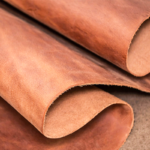The Basic Process of Making Leather
The general process of making leather involves these basic steps:
- Removing the skin from the animal
- Removing the flesh from the skin
- Soaking the skin to loosen the hair
- Scraping or abrading to remove the hair
- Removing some of the layers of the skin (for some methods only)
- Coating the collagen (protein) fibers in the skin with a tanning agent
- Softening
There are lots of different techniques for making leather, as developed all around the world. Today, most commercial leather is made using chemical tanning agents, but originally, the process was all natural. Traditional tanning can be loosely broken down into two categories, and these methods result in very different kinds of leather.
Tanning with Tannins or “Bark Tanning”
Tanning a hide like this involves soaking it in a tannin-rich solution for many weeks, or even months for larger hides. It also requires collecting a whole lot of plant material and steeping giant pots of tea to do the soaking.
The leather that results from bark tanning has a smooth, almost shiny side, and a fuzzier underside. It’s relatively stiff, water resistant, and is usually a dark color, since tannins are also a dying agent. This stuff is great for shoes, bags, belts, etc., and less ideal for clothing. The process of bark tanning is similar to the process of making commercial leather today. However, very few tanneries actually use plant-based tannins anymore; some of the most common chemical tanning agents include chromium and aldehyde.
Tanning with Fat, Lecithin, and Smoke, Or “Brain Tanning”
This one involves using fat and lecithin to coat the collagen fibers, instead of using acidic plant tannins. One good source of both fat and lecithin are brains. Somewhat magically, one deer brain usually provides exactly enough of these compounds to tan one deer hide. In the absence of brains, people make brain-tanned leather using oil, lard, tallow, or even butter for the fat, and usually eggs for the lecithin.
Instead of weeks or months of soaking, brain tanning relies on physical stretching and rubbing to get the “tanning” solution to penetrate the hide. Afterward, the hide is bathed in wood smoke to lock in the solution and ensure that it won’t wash out when exposed to water.
Another difference between these methods is that with brain tanning, the outer layer of skin is scraped off. This layer is called the grain, and it’s where the hair grows. As a result, the finished product is soft on both sides and feels more like suede or buckskin. In fact, the term “buckskin” comes from leather made in this manner, so brain-tanned leather is true, authentic buckskin (even if it’s made of a goat or doe hide).
True buckskin is soft and supple, a tawny color, breathable, and very strong. It’s great for clothing, because it conforms to the shape of the body, and stretches slightly with movement. Since it’s so strong, you can actually cut lengths of thong from it and sew a bag or dress or pants (or whatever you want to make) using no other materials. Finally, for you beaders out there, true buckskin can be adorned with beads without poking your needle all the way through. Your beadwork will stay firmly attached, since the leather’s integrity has been maintained through the natural tanning process.


